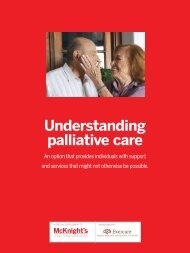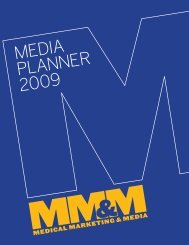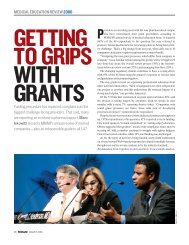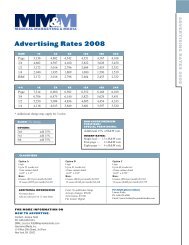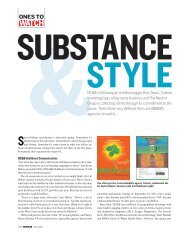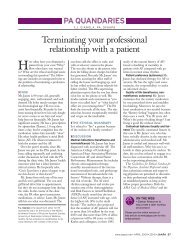Review - Haymarket Media Group
Review - Haymarket Media Group
Review - Haymarket Media Group
Create successful ePaper yourself
Turn your PDF publications into a flip-book with our unique Google optimized e-Paper software.
CaseStudy<br />
Risk of Local Recurrence for Breast Cancer Subtypes<br />
Defined by ER, PR, and HER2 Status<br />
Paul L. Nguyen, MD 1,2 ; Alphonse G. Taghian, MD, PhD 2,3 ; Jay R. Harris, MD 2,4<br />
1 Harvard Radiation Oncology Program; 2 Harvard Medical School; 3 Department of Radiation Oncology, Massachusetts<br />
General Hospital; 4 Department of Radiation Oncology, Dana-Farber Cancer Institute/Brigham and Women’s Hospital;<br />
all Boston, Massachusetts<br />
A60-year-old female had a routine screening<br />
mammogram that showed a 1 cm density<br />
with associated microcalcifications in the<br />
upper outer quadrant of the patient’s left breast. A<br />
core biopsy revealed an infiltrating ductal carcinoma<br />
(IDC), grade 2, with associated ductal carcinoma in<br />
situ (DCIS). The tumor was estrogen receptor (ER)<br />
positive, progesterone receptor (PR) positive, and<br />
HER2 negative. The patient elected breast-conserving<br />
therapy and had a negative sentinel lymph node<br />
biopsy. Pathology from the lumpectomy showed a<br />
1.2 cm grade 2 IDC without evidence of extensive<br />
intraductal component (EIC). There was no lymphovascular<br />
invasion. There was a focally positive inferior<br />
margin, but all other margins were >2 mm. The<br />
Oncotype DX recurrence score was 11 (low risk). A<br />
reexcision of the inferior margin was performed and<br />
was negative except for a single 1 mm focus of DCIS<br />
that came within 1 mm of the final inferior reexcision<br />
margin. The issue of a second reexcision to achieve a<br />
>2 mm inferior margin was discussed, but both the<br />
patient and surgeon were concerned that this might<br />
lead to a poor cosmetic result given the patient’s relatively<br />
small breast size.<br />
Discussion<br />
Classic Predictors of Local Recurrence After Breast-<br />
Conserving Therapy<br />
For women who undergo breast-conserving therapy<br />
for invasive breast cancer, the risk of local recurrence<br />
has been shown in several studies to be based on factors<br />
such as margin status, nodal status, young age,<br />
and presence or absence of EIC (defined as an infiltrating<br />
ductal cancer in which greater than 25% of<br />
the tumor volume is DCIS, and DCIS extends beyond<br />
the invasive cancer into surrounding breast<br />
parenchyma). 1-3<br />
While the exact relative importance of each of the<br />
factors is not always consistent across studies, most<br />
have agreed that margin status is one of the most<br />
important predictors of local recurrence for women<br />
undergoing breast-conserving therapy, and patients<br />
are almost always advised to undergo reexcision if<br />
the tumor involves an inked margin (ie, a positive<br />
margin), unless that positive margin is at the skin or<br />
is a deep margin that has already extended to the<br />
pectoral fascia. The issue of whether a “close margin,”<br />
as our patient has, is a risk factor for local recurrence<br />
is less clear. Investigators have variably<br />
. . . most have agreed that margin<br />
status is one of the most important<br />
predictors of local recurrence.<br />
defined a close margin as having tumor within 1 or 2<br />
mm of the inked surface, and while several studies<br />
have found an association between increasing margin<br />
width and lower local recurrence, only three published<br />
studies have subdivided this width enough to<br />
make finer comparisons. 2,4 One study from Tufts-<br />
New England Medical Center showed a 12-year local<br />
recurrence rate of 9% for margins 0.1 to 2.0 mm, 5%<br />
for 2.1 to 5.0 mm, and 0% for >5 mm. 5 Also, the<br />
Harvard Joint Center for Radiation Therapy found<br />
that 8-year rates of local recurrence were 7% for margins<br />
0.1 to 1.0 mm, 6% for 1.1 to 2.0 mm, and 4% for<br />
November 2008 • Vol 7 • Supplement 5 23



